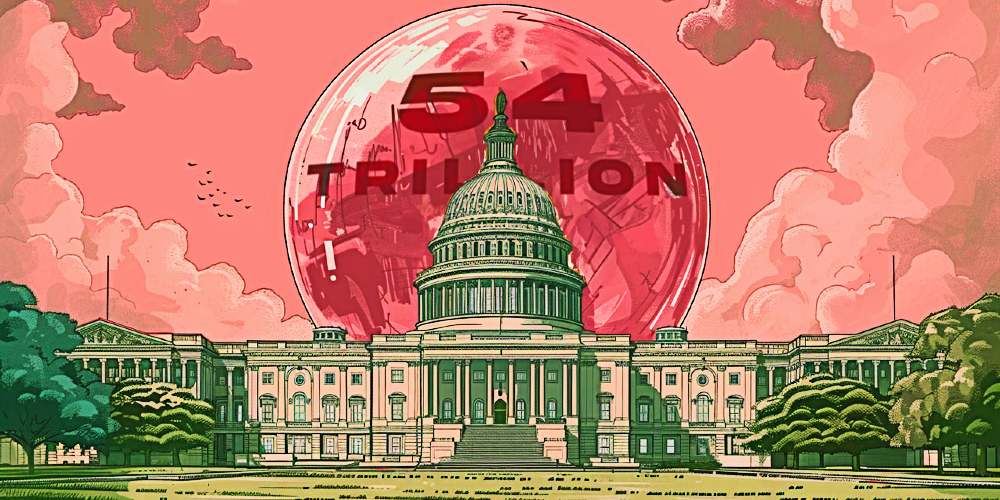(Schiff Gold)—With a stunning trillion dollars added to the national debt in only three months, projected to reach an incomprehensible $54 trillion within 10 years, and America’s interest payments on track to exceed defense spending next year, the question must be asked: How much longer can the debt bubble go?
It’s a curious situation when Jerome Powell, a man who oversaw the largest money-printing campaign in American history, is saying that the debt is unsustainable. While maintaining that the Fed “tries hard not to comment on fiscal policy,” Powell’s suggestion for handling the debt shifts blame and burden from money printing to fiscal irresponsibility on the part of policymakers.
While they have their part to play, and it’s a big one, it’s interesting to see that Federal Reserve monetary policy hasn’t been mentioned in any of Powell’s ‘urgent’ warnings about ballooning debt:
“In the long run, the U.S. is on an unsustainable fiscal path. The U.S. federal government’s on an unsustainable fiscal path. And that just means that the debt is growing faster than the economy. So, it is unsustainable. I don’t think that’s at all controversial. And I think we know that we have to get back on a sustainable fiscal path.”
It’s a wonder how, even if the government suddenly adopted responsible spending and budgeting, we would be back on a path of true sustainability after Powell oversaw the printing of over 3 trillion dollars in 2020 alone. The Fed is an interesting source of criticism for unsustainable debt, to say the least:

More loans and more deposits will increase M1 in an already-frothy inflationary environment, adding pressure to a pot that’s already in danger of boiling over from money printing during Covid. Post-COVID rate hikes have not even come close to reversing this course, with interest still far lower than it would be in an actual free market, where a few dozen bureaucrats would no longer be pulling the levers. Excessive borrowing makes US Treasurys less attractive as doubts begin to mount that the US will be able to pay its obligations back, decreasing demand for our debt and fueling further challenges for funding the government.
All of this led Fitch and Moody’s to downgrade the US’s credit rating last year, from “AAA” to “AA+” in the case of Fitch, and for Moody’s, from “stable” to “negative.” Fed interest rate hikes without an accompanying plan to reduce spending or increase revenue leave no hope at all for meaningfully reducing fiscal deficits.
From this new sense of urgency, lawmakers in Idaho and Wyoming have called for a convention of states to address the problem, with Idaho’s resolutions calling for a possible constitutional amendment limiting the spending abilities and overall power of the federal government. Idaho’s Senate Concurrent Resolution 112, or SCR 112, calls for, in its words:
“(1) imposing fiscal restraints on the federal government; (2) limiting the power and jurisdiction of the federal government; and (3) limiting the terms in office for its officials and for members of Congress. Currently, identical applications have been sent to Congress by other state legislatures.”
The question remains if anything, at this point, would be enough to get the US back on a genuinely sustainable economic track other than an outright collapse of the US dollar leading to a total monetary reset. As long as the Fed exists, the likelihood of truly reigning in out-of-control debt is nothing but a pipe dream.
With recent new all-time highs for gold and bitcoin in response to the debasement of the debt and central banks locked in a buying spree that is likely to last years, the message is clear that the banking system agrees with Peter Schiff that inflation is far from over.
Controlling Protein Is One of the Globalists’ Primary Goals
Between the globalists, corporate interests, and our own government, the food supply is being targeted from multiple angles. It isn’t just silly regulations and misguided subsidies driving natural foods away. Bird flu, sabotaged food processing plants, mysterious deaths of entire cattle herds, arson attacks, and an incessant push to make climate change the primary consideration for all things are combining for a perfect storm to exacerbate the ongoing food crisis.
The primary target is protein. Specifically, they’re going after beef as the environmental boogeyman. They want us eating vegetable-based proteins, lab-grown meat, or even bugs instead of anything that walked the pastures of America. This is why we launched a long-term storage prepper beef company that provides high-quality food that’s shelf-stable for up to 25-years.
At Prepper All-Naturals, we believe Americans should be eating real food today and into the future regardless of what the powers-that-be demand of us. We will never use lab-grown beef. We will never allow our cattle to be injected with mRNA vaccines. We will never bow to the draconian diktats of the climate change cult.
Visit Prepper All-Naturals and use promo code “veterans25” to get 25% off plus free shipping on Ribeye, NY Strip, Tenderloin, and other high-quality cuts of beef. It’s cooked sous vide, then freeze dried and packaged with no other ingredients, just beef. Stock up for the long haul today.


